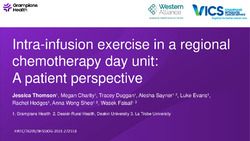Please use this identifier to cite or link to this item:
http://hdl.handle.net/11054/2332Full metadata record
| DC Field | Value | Language |
|---|---|---|
| dc.contributor | Thomson, Jessica | en_US |
| dc.contributor | Charity, Megan | en_US |
| dc.contributor | Duggan, Tracey | en_US |
| dc.contributor | Evans, Luke | en_US |
| dc.contributor | Sayner, Alesha | en_US |
| dc.contributor | Wong Shee, Anna | en_US |
| dc.contributor | Faisal, Wasek | en_US |
| dc.contributor | Hodges, Rachel | en_US |
| dc.date.accessioned | 2024-02-02T08:25:30Z | - |
| dc.date.available | 2024-02-02T08:25:30Z | - |
| dc.date.issued | 2023 | - |
| dc.identifier.govdoc | 02342 | en_US |
| dc.identifier.uri | http://hdl.handle.net/11054/2332 | - |
| dc.description.abstract | Background/aim: The benefits of exercise during cancer treatment are well documented, however exercising at the same time as systemic anti-cancer treatment (SACT), or intra-infusion exercise, remains relatively novel. Patients are routinely sedentary for lengthy periods while receiving their SACT infusion. This time could be used to increase physical activity (PA) and patient confidence that it is safe to engage in PA, even with a cancer diagnosis. Exploring the patient perspective on intra-infusion exercise has not previously been explored. Recent implementation of seated cycling during SACT infusion at Grampians Health Ballarat demonstrated high acceptability from nursing staff. This project aimed to investigate the patient perspective of exercise physiologist implemented and nursing supervised, low-intensity exercise during SACT in a regional health service. Population/setting: Large regional health service Methods: This study forms part of a larger mixed methods project looking at overall patient outcomes and feasibility of implementation of exercise during SACT. This phase of the project adopted a qualitative approach with individual interviews conducted by seven participants with thematic analysis undertaken. Results/findings: Four key themes were identified and labelled. Firstly, overall the program was perceived positively in many facets; patients reported enjoyment in their participation, it helped to pass the time/decrease boredom, and an improvement in overall symptom management was noted. Secondly, staff involvement facilitates exercise; patients felt supported by nurses and valued the EP education provided. Thirdly, procedures and paperwork were burdensome; questionnaires and screening were lengthy, and many steps were required in order to commence the research project. Finally, uptake was seen to be low; with low participation observed and patients acting as advocates for increasing participation. Conclusion: Overall, intra-infusion exercise was viewed positively by patients. Indicators for maintaining or improving exercise self-efficacy and symptomatic management, as well as managing boredom during SACT were strong themes, however streamlining processes would be of benefit. Translational impact/implications for future practice: Intra-infusion exercise is well received by patients and nurses, and is a safe intervention that can be implemented in line with exercise guidelines. Preliminary evaluation of acceptability allows for potential expansion of service provision and monitoring of outcomes for exercise during SACT to be embedded as part of standard care within the organisation. | en_US |
| dc.description.provenance | Submitted by Gemma Siemensma (gemmas@bhs.org.au) on 2023-11-27T05:37:29Z No. of bitstreams: 1 Jessica Thomson WA 2023 3.11.23 FINAL edited comments (002).pdf: 829131 bytes, checksum: 06d24daeac7344b5a3173d57d21ed443 (MD5) | en |
| dc.description.provenance | Approved for entry into archive by Gemma Siemensma (gemmas@bhs.org.au) on 2024-02-02T08:25:30Z (GMT) No. of bitstreams: 1 Jessica Thomson WA 2023 3.11.23 FINAL edited comments (002).pdf: 829131 bytes, checksum: 06d24daeac7344b5a3173d57d21ed443 (MD5) | en |
| dc.description.provenance | Made available in DSpace on 2024-02-02T08:25:30Z (GMT). No. of bitstreams: 1 Jessica Thomson WA 2023 3.11.23 FINAL edited comments (002).pdf: 829131 bytes, checksum: 06d24daeac7344b5a3173d57d21ed443 (MD5) Previous issue date: 2023 | en |
| dc.title | Intra-infusion exercise in a regional chemotherapy day unit: a patient perspective. | en_US |
| dc.type | Conference | en_US |
| dc.type.specified | Presentation | en_US |
| dc.bibliographicCitation.conferencedate | November 21-22 | en_US |
| dc.bibliographicCitation.conferencename | Western Alliance 2023 Symposium. | en_US |
| dc.bibliographicCitation.conferenceplace | Warrnambool, Victoria | en_US |
| dc.subject.healththesaurus | EXERCISE | en_US |
| dc.subject.healththesaurus | CHEMOTHERAPY | en_US |
| dc.subject.healththesaurus | DAY ONCOLOGY | en_US |
| dc.subject.healththesaurus | INTRA-INFUSION | en_US |
| Appears in Collections: | Research Output | |
Files in This Item:
| File | Description | Size | Format | |
|---|---|---|---|---|
| Jessica Thomson WA 2023 3.11.23 FINAL edited comments (002).pdf | 809.7 kB | Adobe PDF |  View/Open |
Items in DSpace are protected by copyright, with all rights reserved, unless otherwise indicated.
